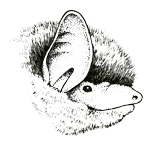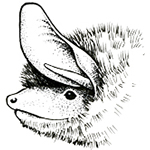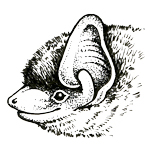Brown long-eared
Plecotus auritus
 As suggested by the name, the brown long-eared bat has remarkably large ears which are nearly as long as its body. It is widespread throughout the Isle of Man, though colonies tend to be small and in older buildings near trees as it feeds on moths and insects on foliage using its ears to detect prey. Look out for brown long-eared bats flitting around the tops of trees.
As suggested by the name, the brown long-eared bat has remarkably large ears which are nearly as long as its body. It is widespread throughout the Isle of Man, though colonies tend to be small and in older buildings near trees as it feeds on moths and insects on foliage using its ears to detect prey. Look out for brown long-eared bats flitting around the tops of trees.
Daubenton’s
Myotis daubentonii
 The Daubenton’s bat is a medium sized bat weighing 7g to 12g and with a wing span of 24cm to 27cm. It was often called the water bat in the past because of its distinctive habit of flying in a level flight about 10cm above the surface of water, for which it is specially adapted. The Daubenton’s feeds on small flies such as caddis flies and midges and roosts in trees or tunnels and bridges, which are generally near water. They can be seen skimming along rivers and across millponds at night.
The Daubenton’s bat is a medium sized bat weighing 7g to 12g and with a wing span of 24cm to 27cm. It was often called the water bat in the past because of its distinctive habit of flying in a level flight about 10cm above the surface of water, for which it is specially adapted. The Daubenton’s feeds on small flies such as caddis flies and midges and roosts in trees or tunnels and bridges, which are generally near water. They can be seen skimming along rivers and across millponds at night.
Leisler’s
Nyctalus leisleri
 Leisler’s is the biggest of the Island’s bats with a body length of between 50mm and 68mm and weighing between 11g and 20g. They are typically two to three times as big as pipistrelles. Leisler’s are early emerging bats that fly high and fast but will also fly low along lanes or roads. They have even been found on the beach skimming above the seaweed. They feed on large insects and can forage over wide areas.
Leisler’s is the biggest of the Island’s bats with a body length of between 50mm and 68mm and weighing between 11g and 20g. They are typically two to three times as big as pipistrelles. Leisler’s are early emerging bats that fly high and fast but will also fly low along lanes or roads. They have even been found on the beach skimming above the seaweed. They feed on large insects and can forage over wide areas.
Natterer’s
Myotis nattereri
 The Natterer’s bat (named after a famous Austrian naturalist) favours roosts in old buildings and trees and often winters in underground caves or tunnels. It is similar to the Daubenton’s bat.
The Natterer’s bat (named after a famous Austrian naturalist) favours roosts in old buildings and trees and often winters in underground caves or tunnels. It is similar to the Daubenton’s bat.
Pipistrelle
Pipistrellus pipistrellus
 These are the Island’s commonest and the smallest bats, weighing about 4g to 6g and having a wingspan of 19cm to 25cm. They eat midges, mosquitoes and other small insects that they catch and eat on the wing. A single pipistrelle can eat up to 3000 midges, caddis flies, mosquitoes and other similar small insects in a night. They can be seen after dusk as they leave their roosts or where they feed in woodland, over water, along hedgerows and even over gardens.
These are the Island’s commonest and the smallest bats, weighing about 4g to 6g and having a wingspan of 19cm to 25cm. They eat midges, mosquitoes and other small insects that they catch and eat on the wing. A single pipistrelle can eat up to 3000 midges, caddis flies, mosquitoes and other similar small insects in a night. They can be seen after dusk as they leave their roosts or where they feed in woodland, over water, along hedgerows and even over gardens.
Soprano pipistrelle
Pipistrellus pygmaeus
 The pipistrelle has been recently recognised as consisting of two separate species. The soprano pips are so called because they can be detected at a higher frequency than the common pips. Both pipistrelles mostly roost in newer buildings, for example under eaves and soffit boards, which means that their roosts are found more often than those of other species.
The pipistrelle has been recently recognised as consisting of two separate species. The soprano pips are so called because they can be detected at a higher frequency than the common pips. Both pipistrelles mostly roost in newer buildings, for example under eaves and soffit boards, which means that their roosts are found more often than those of other species.
Whiskered
Myotis mystacinus
 Whiskered bats are not much bigger than pipistrelles and weigh between 4g and 8g with a body length of between 35mm and 48mm. They are rather particular about their preferred habitat and are consequently not very numerous in the Isle of Man.
Whiskered bats are not much bigger than pipistrelles and weigh between 4g and 8g with a body length of between 35mm and 48mm. They are rather particular about their preferred habitat and are consequently not very numerous in the Isle of Man.
